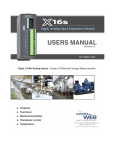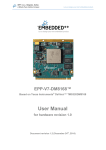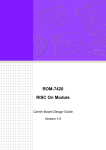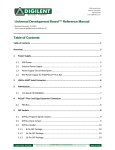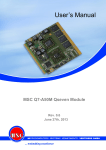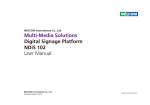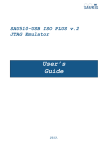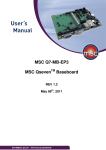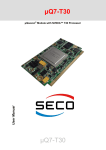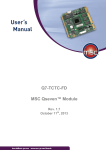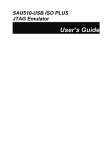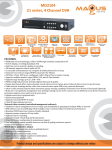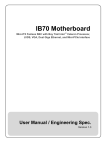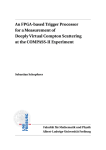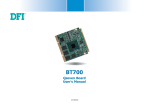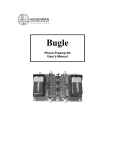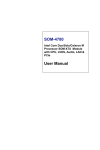Download Q7-TI8168 user manual
Transcript
MSC Q7-TI8168 Module (Texas Instruments® DaVinci™) Rev. 1.1 January 28th, 2013 Hardware Revision 2.0 Q7-TI8168 User's Manual Preface Copyright Notice Copyright © 2012 MSC Vertriebs GmbH. All rights reserved. Copying of this document, and giving it to others and the use or communication of the contents thereof, is forbidden without express authority. Offenders are liable to the payment of damages. All rights are reserved in the event of the grant of a patent or the registration of a utility model or design. Important Information This documentation is intended for qualified audience only. The product described herein is not an end user product. It was developed and manufactured for further processing by trained personnel. Disclaimer Although this document has been generated with the utmost care no warranty or liability for correctness or suitability for any particular purpose is implied. The information in this document is provided “as is” and is subject to change without notice. EMC Rules This unit has to be installed in a shielded housing. If not installed in a properly shielded enclosure, and used in accordance with the instruction manual, this product may cause radio interference in which case the user may be required to take adequate measures at his or her owns expense. Trademarks All used product names, logos or trademarks are property of their respective owners. Certification MSC Vertriebs GmbH is certified according to DIN EN ISO 9001:2000 standards. Life-Cycle-Management MSC products are developed and manufactured according to high quality standards. Our lifecycle-management assures long term availability through permanent product maintenance. Technically necessary changes and improvements are introduced if applicable. A productchange-notification and end-of-life management process assures early information of our customers. Product Support MSC engineers and technicians are committed to provide support to our customers whenever needed. Before contacting Technical Support of MSC Vertriebs GmbH, please consult the respective pages on our web site at www.mscembedded.com/support-center for the latest documentation, drivers and software downloads. If the information provided there does not solve your problem, please contact our Technical Support: Email: [email protected] Phone: +49 8165 906-200 2 Q7-TI8168 User's Manual Content 1 General Information ...................................................................................................... 5 1.1 Revision History........................................................................................................ 5 1.2 Reference Documents .............................................................................................. 5 1.3 Signal Terminology ................................................................................................... 6 1.4 Introduction............................................................................................................... 6 2 Technical Information ................................................................................................... 7 2.1 Key features ............................................................................................................. 7 2.2 Jumpers and switches .............................................................................................. 8 2.3 Watchdog ................................................................................................................. 8 2.4 Power dissipation ..................................................................................................... 8 2.5 Block diagram ........................................................................................................... 9 2.6 LEDs .......................................................................................................................10 2.7 Signal description ....................................................................................................11 2.7.1 2.7.2 2.7.3 2.7.4 2.7.5 2.7.6 2.7.7 2.7.8 2.7.9 2.7.10 2.7.11 2.7.12 2.7.13 PCI Express Lanes .......................................................................................................... 11 Ethernet ........................................................................................................................... 12 Serial ATA ........................................................................................................................ 13 USB .................................................................................................................................. 14 SDIO ................................................................................................................................ 15 2 Audio – I S ....................................................................................................................... 15 LVDS Flat Panel .............................................................................................................. 16 HDMI ................................................................................................................................ 17 LPC Bus ........................................................................................................................... 17 SPI Interface .................................................................................................................... 18 Input Power Pins .............................................................................................................. 19 Manufacturing Signals ..................................................................................................... 19 Power and System Management..................................................................................... 20 3 System resources ........................................................................................................21 3.1 I2C Bus Address Map ..............................................................................................21 4 Mechanical drawing .....................................................................................................22 5 Heat spreader ...............................................................................................................23 6 Boot options.................................................................................................................25 6.1 SD Card boot mode and SPI Flash boot mode ........................................................25 7 Connectors ...................................................................................................................26 7.1 Overview .................................................................................................................26 7.2 MXM Connector (X1) ...............................................................................................27 7.3 Feature Connector (X2) ...........................................................................................30 8 Power Domains ............................................................................................................32 3 Q7-TI8168 User's Manual 4 Q7-TI8168 1 User's Manual General Information 1.1 Revision History Rev. Date Pages 1.0 1.06.2012 All 28.01.2013 7 8 9 15 18 19 25 31 1.1 Description Initial Version Hardware Revision 1.0 - - Audio compatibility updated Power dissipation details added SPI Flash added to block diagram 2 Added SDIO signals pull-ups, audio signals updated to I S SPI_CS1# signal not supported on Feature connector Added note for JTAG signals Boot options updated SPI_CS1# signal removed from Feature connector 1.2 Reference Documents [1] Qseven Specification Revision 2.0 Last update: September 20th 2012 http://www.Qseven-standard.org 5 Q7-TI8168 User's Manual 1.3 Signal Terminology Signal direction: Signal directions are from the module perspective. For example: COM_TXD (serial port transmit) is an output from the CPU module The “#” symbol at the end of the signal name indicates that the active or asserted state occurs when the signal is at a low voltage level. When “#” is not present, the signal is active at a high voltage level Differential pairs are indicated by trailing “+” and “-“ signs for the positive or negative signal 1.4 Introduction The MSC Q7-TI8168 is part of the MSC Qseven family of Qseven CPU modules. It is based on a Texas Instruments DaVinciTM System-on-a-Chip (SoC) which incorporates a high performance ARM CortexTM A8 RISC MPU together with TI’s C674x VLIW DSP core. The module is fully compliant with the Qseven Specification Revision 2.0. All functionalities are listed in the Technical Information section. Depending on the assembly variant different subsets are available. 6 Q7-TI8168 User's Manual 2 Technical Information 2.1 Key features CPU ARM® CortexTM A8 processor, 1,2GHz 32KB instruction and data caches 256KB L2 cache 64KB RAM, 48KB boot ROM C674x floating/fixed point DSP operating up to 1 GHz Up to 8000/6000 C674x MIPS/MFLOPS Memory 32-bit DDR3, 800MHz, 1GByte Audio-Video Processor HD Three HDVICP2 hardware accelerator subsystems supports resolutions up to 1080 p/i with full performance of 60 fps Dual Display Controller MPEG4 encoding & decoding MPEG2 encoding & decoding MPEG1 encoding & decoding H.264 encoding & decoding DivX 5.x and higher, encoding & decoding RV/ON2 decoding AVS 1.0 encoding & decoding WMV9/ VC1/RTV encoding & decoding JPEG/MJPEG encoding & decoding HDMI 1.3 – Full HD (1080p) LCD (single channel 24bpp) – up to WXGA+ (1440 x 900 @ 60Hz) Video input 8 bit YCbCr video input up to 165MHz (available on feature connector) GPU SGX530 3D Graphics Engine Delivers up to 30 MTriangles/s Direct3D® Mobile, OpenGL® ES 1.1 and 2.0, OpenVG™ 1.1, OpenMax™ API Support Ethernet Lantiq® XWAY PEF7072, IEEE 802.3 compliant (10/100/1000) PCI Express One x1 PCIe 1.1 port Audio I2S compatible USB Integrated 2 ports USB 2.0 Controller (1x Host, 1x Host/Client), PCIe to USB Swidge for 4 additional USB 2.0 ports SATA 2 SATA 3.0 interfaces 7 Q7-TI8168 User's Manual Serial, SPI, I2C Flash Memory 2 integrated UART Controllers (1 on feature connector) integrated SPI Controller (3 slave selects, 1 on feature connector) integrated I2C Controller NAND Flash, 2GB (8Bit data bus) SPI Flash, 4 MB, 40 MHz SDIO Integrated 4 bit SD/MMC Controller (SD, MMC, SDHC, SDIO), maximum frequency 48MHz RTC RTC with I2C-Interface (typ. Power Consumption 350nA @ 3V) Boot sources* Power Supply NAND Flash SPI Flash SD Card Ethernet 5V (4,75V – 5,25V) 5V (4,75V – 5,25V) Standby voltage 3V (1,3V – 3,3V) optionally for RTC *U-boot must be resident on the SPI Flash or the SD Card 2.2 Jumpers and switches There are no jumpers or switches on the module. 2.3 Watchdog t.b.d 2.4 Power dissipation Mode Voltage Current Power Description Measured at the login prompt ten minutes after booting Idle 5V 1.655 A 8.275 W CPU tests 5V 1.823 A 9.115 W HD video 5V 1.9 A 9.5 W Measured while running CPU tests fifteen minutes after booting (LINPACK CPU test) Measured while decoding HD video (hardware accelerated) two minutes after rebooting 8 Q7-TI8168 User's Manual 2.5 Block diagram Q7 FEATURE CONNECTOR (40pins) DaVinci SPI UART VIDEO IN C674x DSP CPU 3D Graphics 2x SATA PCIe0 DDR3-1600 1 Gbyte max. DDR3MEMORY INTERFACE NAND FLASH 4 Gbyte max. GENERAL MEMORY INTERFACE PCIe - to - 4 x USB Swidge PCIE0 USB 2-5 USB1 (HOST/CLIENT) Texas Instruments USB0 ARM Cortex A8 SPI Flash SD-CARD (4 bit) SPI I2C JTAG SMB I2C I2S RTC HDMI LVDS Transmitter LVDS-A UART JTAG I2C UART VOUT 24bit TEMP sensor Power Management GMII Gigabit Ethernet Gigabit Ethernet MFG_NC_0/1/2/3/4 MUX RTC Backup Supply Version 1.1 9 Q7 BOARD-to-BOARD CONNECTOR MSC-Q7-TI8168 Q7-TI8168 User's Manual 2.6 LEDs There are six onboard LEDs. All of them are available as USER LEDs. 12 3 4 5 6 10 Q7-TI8168 User's Manual 2.7 Signal description In the following tables signals are marked with the power rail associated with the pin, and, for input and I/O pins, with the input voltage tolerance. The pin power rail and the pin input voltage tolerance may be different. An additional label, “Suspend”, indicates that the pin is active during suspend states (S3, S5). If suspend modes are used, then care must be taken to avoid loading signals that are active during suspend to avoid excessive suspend mode current draw. 2.7.1 PCI Express Lanes Pin Type PCIE0_TX+ PCIE0_TXPCIE0_RX+ PCIE0_RX- O Signal Level PCIe I PCIe CPU PCIE_CLK_REF+ PCIE_CLK_REF- O PCIe CPU PCIE_RST# O CMOS CPU Signal Power Rail CPU Remark / Power Tol. AC coupled on module Requires AC coupling on baseboard AC coupled on module 3.3V PU/PD Description 5k1 PD 11 Source / Target PCI Express 1.1 Differential Transmit Pairs 0 DaVinci PCI Express 1.1 Differential Receive Pairs 0 / DaVinci PCI Express Reference Clock for Lane 0 Clock generator Reset Signal for external devices. PCIe-to-USB Swidge Q7-TI8168 2.7.2 User's Manual Ethernet Signal GBE_MDI[0:3]+ GBE_MDI[0:3]- Pin Type Input/ Output Signal Level Analog Power Rail Power Tolerance Suspend PU/PD Description Source / Target Gigabit Ethernet Controller: Media Dependent Interface Differential Pairs 0,1,2,3. The MDI can operate in 1000, 100 and 10 Mbit / sec modes. Gigabit Ethernet Controller 1000BASE-T MDI configuration: MDI[0]+/MDI[1]+/MDI[2]+/MDI[3]+/- BI_DA+/BI_DB+/BI_DC+/BI_DD+/- MDI-X configuration: MDI[0]+/MDI[1]+/MDI[2]+/MDI[3]+/- BI_DB+/BI_DA+/BI_DC+/BI_DD+/- 100BASE-TX/ 10BASE-T MDI configuration: MDI[0]+/MDI[1]+/MDI[2]+/MDI[3]+/- Transmit Receive unused unused MDI-X configuration: MDI[0]+/MDI[1]+/MDI[2]+/MDI[3]+/- Receive Transmit unused unused GBE_ACT# OD CMOS CPU 3.3V Gigabit Ethernet Controller: activity indicator, active low. Logic GBE_LINK# OD CMOS CPU 3.3V Gigabit Ethernet Controller: link indicator, active low. Logic GBE_LINK100# OD CMOS CPU 3.3V Gigabit Ethernet Controller: 100 Mbit / sec link indicator, active low. Logic GBE_LINK1000# OD CMOS CPU 3.3V Gigabit Ethernet Controller: 1000 Mbit / sec link indicator, active low. Logic GBE_CTREF REF GND min 3.3V max Gigabit Ethernet Controller (1000MBit) : unconnected Unconnected / Not required 12 Q7-TI8168 2.7.3 User's Manual Serial ATA Signal SATA0_TX+ SATA0_TXSATA0_RX+ SATA0_RXSATA1_TX+ SATA1_TXSATA1_RX+ SATA1_RXSATA_ACT# Pin Type O Signal Level SATA CPU I SATA CPU O SATA CPU I SATA CPU OD CMOS CPU Power Rail Remark AC coupled on module AC coupled on module AC coupled on module AC coupled on module 3.3V PU/PD Description Source / Target Serial ATA Channel 0: differential transmit pair. DaVinci Serial ATA Channel 0: differential receive pair. / DaVinci Serial ATA Channel 1: differential transmit pair. DaVinci Serial ATA Channel 1: differential receive pair. / DaVinci SATA activity indicator (both channels), active low. External Pullup has to be installed on Carrier Board. Logic 13 Q7-TI8168 2.7.4 User's Manual USB Pin Type I/O Signal Level USB CPU USB differential pair, channels 0 DaVinci I/O USB CPU DaVinci I/O USB CPU USB differential pair, channels 1 This port may be optionally used as USB client port. USB differential pairs, channels 2 to 5 I CMOS CPU 3.3V 1k43 PU USB_2_3_OC# I CMOS CPU 3.3V 4k7 PU USB_4_5_OC# I CMOS CPU 3.3V 4k7 PU USB_ID I CMOS CPU 3.3V USB_CC I CMOS CPU 3.3V Signal USB_P0+ USB_P0USB_P1+ USB_P1USB[2:5]+ USB[2:5]USB_0_1_OC# Power Rail Remark / Power Tol. PU/PD Description USB over-current sense, USB channels 0 and 1. A pull-up for this line is present on the module. An open drain driver from a USB current monitor on the Carrier Board may drive this line low. Do not pull this line high on the Carrier Board. USB over-current sense, USB channels 2 and 3. A pull-up for this line is present on the module. An open drain driver from a USB current monitor on the Carrier Board may drive this line low. Do not pull this line high on the Carrier Board. USB over-current sense, USB channels 4 and 5. A pull-up for this line is present on the module. An open drain driver from a USB current monitor on the Carrier Board may drive this line low. Do not pull this line high on the Carrier Board. USB ID pin. High signal level configures USB Port1 (and CPU) as USB Client USB client connect pin. 14 Source / Target PCIe-to-USB Swidge DaVinci / PCIe-to-USB Swidge / PCIe-to-USB Swidge / DaVinci / DaVinci Q7-TI8168 2.7.5 User's Manual SDIO Signal SDIO_DAT[0:3] SDIO_CD# SDIO_CMD SDIO_CLK SDIO_PWR# SDIO_LED SDIO_WP Pin Type I/O I I/O O I/O O I Signal Level 3.3V 3.3V 3.3V 3.3V 3.3V 3.3V 3.3V Power Rail CPU CPU CPU CPU CPU CPU CPU Remark / Power Tol. 3.3V 3.3V 3.3V 3.3V 3.3V 3.3V 3.3V PU/PD 10k PU 10k PU 10k PU 10k PU 10k PD Description SDIO Controller Data SDIO Controller Card Detect SDIO Controller Command SDIO Controller Clock SDIO Controller Power enable SDIO Controller transfer activity LED SDIO Controller Write Protect Source / Target DaVinci / DaVinci DaVinci DaVinci Logic DaVinci / DaVinci 2.7.6 Audio – I2S Signal I2S_RST# I2S_WS I2S_CLK I2S_SDO I2S_SDI Pin Type Output Output Output Output Input Signal Level CMOS CMOS CMOS CMOS CMOS Power Rail CPU CPU CPU CPU CPU Power Tolerance 3.3V 3.3V 3.3V 3.3V 3.3V PU/PD 10k PD Description Reset output to CODEC, active low I2S Word Select output I2S Serial Data Clock to CODEC Serial Data Output to CODEC Serial Data Input from CODEC 15 Source / Target DaVinci DaVinci DaVinci DaVinci / DaVinci Q7-TI8168 User's Manual 2.7.7 LVDS Flat Panel LVDS_A[0:3]+ LVDS_A[0:3]LVDS_A_CLK+ LVDS_A_CLKLVDS_PPEN O Signal Level LVDS O LVDS CPU O CMOS CPU 3.3V LVDS_BLEN O CMOS CPU 3.3V LVDS_BLT_CTRL O CMOS CPU 3.3V LVDS_DID_CLK I/O OD CMOS CPU 3.3V LVDS_DID_DAT I/O OD CMOS CPU 3.3V Signal Pin Type Power Rail CPU Remark / Power Tol. LVDS panel power enable Source / Target LVDS Transmitter LVDS Transmitter DaVinci LVDS panel backlight enable DaVinci LVDS panel backlight brightness control DaVinci 1k43 PU I2C clock output for LVDS display use I2C Switch 1k43 PU I2C data line for LVDS display use I2C Switch PU/PD Description LVDS Channel A differential pairs – primary channel LVDS Channel A differential clock 10k PD 16 Q7-TI8168 User's Manual 2.7.8 HDMI TMDS_LANE0+ TMDS_LANE0TMDS_LANE1+ TMDS_LANE1TMDS_LANE2+ TMDS_LANE2TMDS_CLK+ TMDS_CLKHDMI_HPD# O Signal Level HDMI TMDS differential pair lines lane 0 Source / Target DaVinci O HDMI CPU TMDS differential pair lines lane 1 DaVinci O HDMI CPU TMDS differential pair lines lane 2 DaVinci O HDMI CPU TMDS differential pair clock lines DaVinci I CMOS CPU / DaVinci HDMI_CTRL_CLK I/O OD CMOS CPU 3.3V 40k2 PU Hot plug detection signal that serves as an interrupt request. Signal can only be pulled to a logic low level. DDC based control signal (clock) for HDMI device HDMI_CTRL_DAT I/O OD CMOS CPU 3.3V 40k2 PU DDC based control signal (data) for HDMI device DaVinci Signal Level CMOS CMOS Power Rail CPU CPU Remark / Power Tol. Not supported Not supported Signal 2.7.9 Pin Type Power Rail CPU Remark / Power Tol. PU/PD 10k PD Description DaVinci LPC Bus Signal LPC_FRAME# LPC_CLK Pin Type O O PU/PD Description Not supported Not supported 17 Source / Target Not supported Not supported Q7-TI8168 User's Manual 2.7.10 SPI Interface SPI_MOSI SPI_MISO SPI_SCK SPI_CS0# Pin Type O I O O Signal Level CMOS CMOS CMOS CMOS SPI_CS1# O SPI_CS2# O Signal CPU CPU CPU CPU Remark / Power Tol. 3.3V 3.3V 3.3V 3.3V 5k1 PU CMOS CPU 3.3V 5k1 PU CMOS CPU 3.3V 5k1 PU Power Rail PU/PD Description Master serial output / Slave input signal – CPU is master Master serial input / Slave output signal – CPU is master SPI clock input SPI chip select 1 output, active low (chip select for primary device) on Qseven connector SPI chip select 2 output, active low (chip select for secondary device) on Qseven connector SPI chip select 3 output, active low (chip select for primary device) on Feature connector 18 Source / Target Logic / Logic Logic DaVinci DaVinci DaVinci Q7-TI8168 User's Manual 2.7.11 Input Power Pins VCC Pin Type Power VCC_5V_SB Power VCC_RTC GND Power Power Signal Signal Level Power Rail 5V Remark / Power Tol. (±5%) 5V (±5%) PU/PD Description Primary power input: +5V (±5%) Standby power input: +5.0V (±5%) All available VCC5V0_STBY pins on the connector(s) shall be used. Used for microcontroller and standby and suspend functions. NOTE: If the baseboard does not provide the VCC_5V_SB then these pins should be connected to the main VCC power supply on the baseboard! Real-time clock circuit-power input : +3.0V (+1.3V to +3.3V) Ground - DC power and signal and AC signal return path. All available GND connector pins shall be used and tied to Carrier Board GND plane. Source / Target / Voltage Regulators / Voltage Regulators / RTC 2.7.12 Manufacturing Signals Pin Type I O Signal Level CMOS CMOS Power Rail CPU CPU Remark / Power Tol. 3.3V 3.3V MFG_NC2 I CMOS CPU 3.3V MFG_NC3 2 MFG_NC4 I I CMOS CMOS CPU CPU 3.3V 3.3V Signal MFG_NC0 MFG_NC1 1 PU/PD 4k7 PD Description Boundary Scan – TCK Boundary Scan – TDO / COM_TXD: Depending on MFG_NC4 the signal is either used as Boundary Scan TDO or as transmit signal for the serial debug port (UART) Boundary Scan – TDI / COM_RXD: Depending on MFG_NC4 the signal is either used as Boundary Scan TDI or as receive signal for the serial debug port (UART) Boundary Scan – TMS Control Signal for multiplexer circuit: 1: Boundary Scan / JTAG 0: UART Source / Target / DaVinci DaVinci / DaVinci / DaVinci / DaVinci 1 On some JTAG debuggers, which require return clock from processor, pins TCK and RCK should be connected (pins 11 and 9 on Standard TI 14-pin JTAG Header). 2 This signal should have defined default logic level (pull-up or pull-down resistor on the carrier board). 19 Q7-TI8168 User's Manual 2.7.13 Power and System Management Pin Type PWRBTN# I Signal Level CMOS RSTBTN# I CMOS Suspend 3.3V 10k PU SUS_STAT# SUS_S3# O O CMOS CMOS Suspend 3.3V 10k PD SUS_S5# O CMOS Suspend 3.3V 10k PD LID_BTN# SLP_BTN# BATLOW# WAKE# THRM# THERMTRIP# PWGIN WDOUT WDTRIG# GP_TIMER_IN GP_PWM_OUT1 SPKR SMB_CLK* SMB_DAT SMB_Alert I2C_CLK I2C_DAT I I I I I O I O I I OD O I/O I/O I/O I/O I/O CMOS CMOS CMOS CMOS CMOS CMOS 5V CMOS CMOS CMOS CMOS CMOS CMOS CMOS CMOS CMOS CMOS CMOS Signal Power Rail Suspend Remark / Power Tol. 3.3V 10k PU Suspend 3.3V Suspend Suspend Suspend CPU CPU Suspend Suspend CPU CPU CPU CPU CPU CPU 3.3V 3.3V 5V 3.3V 3.3V 3.3V 3.3V 3.3V 3.3V 3.3V 3.3V 3.3V 3.3V PU/PD 10k PU 10k PU 10k PD 10k PU 10k PU 10k PU 1k43 PU 1k43 PU Description Power button to bring system into a power state, active low (negative pulse, 6 seconds power override) Reset button input. Active low input. System is held in hardware reset while this input is low, and comes out of reset upon release. (negative pulse) Not supported. Indicates that the system is in Soft Off state. Can be used to control an ATX power supply. Indicates that the system is in Soft Off state. Also known as "PS_ON" and can be used to control an ATX power supply. Not supported. Not supported. Signal that indicates that the system battery is low. Not supported. Input from off-module temp sensor indicating an over-temp situation. Active low output indicating that the CPU has entered thermal shutdown. Indicates that the external power supply is ready Output indicating that a watchdog time-out event has occurred. Watchdog trigger input. This signal restarts the watchdog timer General purpose timer input General purpose PWM output Output for audio enunciator. System management clock line System management data line System management bus alert input General purpose I2C port clock output General purpose I2C port data I/O line *SMBus covers complete address range 20 Source / Target /Microcontroller /Microcontroller Not supported. Microcontroller Microcontroller Not supported. Not supported. /Microcontroller Not supported. /Microcontroller Microcontroller /Microcontroller DaVinci DaVinci /Microcontroller Microcontroller DaVinci Microcontroller Microcontroller Microcontroller I2C Switch I2C Switch Q7-TI8168 User's Manual 3 System resources 3.1 I2C Bus Address Map The on-board I2C switch splits the I2C bus into two branches: - Qseven on-module I2C - System I2C going to the Qseven connector Device I2C Switch A6 A5 A4 A3 A2 A1 1 1 1 0 0 0 A0 R/W address *) 0 x E0h / E1h A0 R/W address *) Available devices on Qseven on-module branch: Device A6 A5 A4 A3 A2 A1 ID-EEPROM 1 0 1 0 0 0 0 x A0h / A1h RTC 1 1 0 1 0 0 0 x D0h / D1h *) 8 bit address R/W 21 Q7-TI8168 User's Manual 4 Mechanical drawing The actual height depends on the Qseven connector used on the baseboard. 22 Q7-TI8168 5 User's Manual Heat spreader The cooling solution for a Qseven module is based on a heat spreader concept. The purpose of the heat spreader is to provide a standard thermal interface. A heat spreader is a metal plate (typically aluminium) mounted on top of the module. Its mechanical dimensions follow the module standard specification. The connection between the metal plate and the thermal active components on the module is typically made via thermal interface materials such as phase change foils, gap pads and metal blocks. A good thermal conductivity is required in order to transfer the heat from the hotspots to the heat spreader plate. The heat spreader used for the MSC Q7-TI8168 CPU module is thermally attached using phase change materials and a small aluminium block that is part of the heat spreader plate. Usage of the heat spreader is obligatory, but there might be applications that require additional type of cooling solution together with heat spreader (passive casing heat dissipation or cooling fan). In any case it is the system designer’s responsibility to make sure that each device in the system operates within its specified thermal limits. The cooling solution should ensure that the thermal specifications for each component are met over the full operating range of the system. 23 Q7-TI8168 User's Manual 24 Q7-TI8168 User's Manual 6 Boot options The MSC Q7-TI8168 has several booting options. 6.1 SD Card boot mode and SPI Flash boot mode SD card boot is of higher priority than SPI Flash boot. If a card is present but doesn't contain a valid bootloader, the CPU will skip to SPI Flash. Subsequently the kernel can be loaded from Ethernet, NAND Flash or SD Card. 25 Q7-TI8168 User's Manual 7 Connectors 7.1 Overview X2 X3 X1 Function Description X1 Qseven Finger – 230pins Qseven edge contacts to connect to MXM connector (refer to Qseven specification) X2 Qseven Feature Connector – 40pins Optional Qseven I/O-Connector with additional features 26 Q7-TI8168 User's Manual 7.2 MXM Connector (X1) NOTE: Signals in grey are not available on the MSC-Q7-TI8168 module Pin Signal Pin Signal 1 GND 2 GND 3 GBE_MDI3- 4 GBE_MDI2- 5 GBE_MDI3+ 6 GBE_MDI2+ 7 GBE_LINK100# 8 GBE_LINK1000# 9 GBE_MDI1- 10 GBE_MDI0- 11 GBE_MDI1+ 12 GBE_MDI0+ 13 GBE_LINK# 14 GBE_ACT# 15 GBE_CTREF 16 SUS_S5# 17 WAKE# 18 SUS_S3# 19 SUS_STAT# 20 PWRBTN# 21 SLP_BTN# 22 LID_BTN# 23 GND 24 GND KEY 25 GND 26 PWGIN 27 BATLOW# 28 RSTBTN# 29 SATA0_TX+ 30 SATA1_TX+ 31 SATA0_TX- 32 SATA1_TX- 33 SATA_ACT# 34 GND 35 SATA0_RX+ 36 SATA1_RX+ 37 SATA0_RX- 38 SATA1_RX- 39 GND 40 GND 41 BIOS_DISABLE# / BOOT_ALT# 42 SDIO_CLK# 43 SDIO_CD# 44 SDIO_LED 45 SDIO_CMD 46 SDIO_WP 47 SDIO_PWR# 48 SDIO_DAT1 49 SDIO_DAT0 50 SDIO_DAT3 SDIO_DAT2 52 SDIO_DAT5 51 27 Q7-TI8168 User's Manual 53 SDIO_DAT4 54 SDIO_DAT7 55 SDIO_DAT6 56 RSVD 57 GND 58 GND 59 HDA_SYNC / I2S_WS 60 SMB_CLK 61 HDA_RST# / I2S_RST# 62 SMB_DAT 63 HDA_BITCLK / I2S_CLK 64 SMB_ALERT# 65 HDA_SDI / I2S_SDI 66 I2C_CLK 67 HDA_SDO / I2S_SDO 68 I2C_DAT 69 THRM# 70 WDTRIG# 71 THRMTRIP# 72 WDOUT 73 GND 74 GND 75 USB_P7- 76 USB_P6- 77 USB_P7+ 78 USB_P6+ 79 USB_6_7_OC# 80 USB_4_5_OC# 81 USB_P5- 82 USB_P4- 83 USB_P5+ 84 USB_P4+ 85 USB_2_3_OC# 86 USB_0_1_OC# 87 USB_P3- 88 USB_P2- 89 USB_P3+ 90 USB_P2+ 91 USB_CC 92 USB_ID 93 USB_P1- 94 USB_P0- 95 USB_P1+ 96 USB_P0+ 97 GND 98 GND 99 LVDS_A0+ 100 LVDS_B0+ 101 LVDS_A0- 102 LVDS_B0- 103 LVDS_A1+ 104 LVDS_B1+ 105 LVDS_A1- 106 LVDS_B1- 107 LVDS_A2+ 108 LVDS_B2+ 109 LVDS_A2- 110 LVDS_B2- 111 LVDS_PPEN 112 LVDS_BLEN 113 LVDS_A3+ 114 LVDS_B3+ 115 LVDS_A3- 116 LVDS_B3- 117 GND 118 GND 119 LVDS_A_CLK+ 120 LVDS_B_CLK+ 121 LVDS_A_CLK- 122 LVDS_B_CLK- 123 LVDS_BLT_CTRL / GP_PWM_OUT0 124 RSVD 125 LVDS_DID_DAT / GP_I2C_DAT 126 LVDS_BLC_DAT 127 LVDS_DID_CLK / GP_I2C_CLK 128 LVDS_BLC_CLK 129 CAN0_TX 130 CAN0_RX 131 SDVO_BCLK+ / HDMI_TMDS_CLK+ 132 SDVO_INT+ 133 SDVO_BCLK- / HDMI_TMDS_CLK- 134 SDVO_INT- 135 GND 136 GND 137 SDVO_GREEN+ / HDMI_TMDS_LINE1+ 138 SDVO_FLDSTALL+ 139 SDVO_GREEN- / HDMI_TMDS_LINE1- 140 SDVO_FLDSTALL- 141 GND 142 GND 143 SDVO_BLUE+ / HDMI_TMDS_LINE0+ 144 SDVO_TVCLKIN+ 145 SDVO_BLUE- / HDMI_TMDS_LINE0- 146 SDVO_TVCLKIN- 147 GND 148 GND 149 SDVO_RED+ / HDMI_TMDS_LINE2+ 150 SDVO_CTRL_DAT / HDMI_CTRL_DAT SDVO_RED- / HDMI_TMDS_LINE2- 152 SDVO_CTRL_CLK / HDMI_CTRL_CLK 151 28 Q7-TI8168 User's Manual 153 HDMI_HPD# 154 DP_HPD# 155 PCIE_CLK_REF+ 156 PCIE_WAKE# 157 PCIE_CLK_REF- 158 PCIE_RST# 159 GND 160 GND 161 PCIE3_TX+ 162 PCIE3_RX+ 163 PCIE3_TX- 164 PCIE3_RX- 165 GND 166 GND 167 PCIE2_TX+ 168 PCIE2_RX+ 169 PCIE2_TX- 170 PCIE2_RX- 171 EXCD0_PERST# 172 EXCD1_PERST# 173 PCIE1_TX+ 174 PCIE1_RX+ 175 PCIE1_TX- 176 PCIE1_RX- 177 EXCD0_CPPE# 178 EXCD1_CPPE# 179 PCIE0_TX+ 180 PCIE0_RX+ 181 PCIE0_TX- 182 PCIE0_RX- 183 GND 184 GND 185 LPC_AD0 186 LPC_AD1 187 LPC_AD2 188 LPC_AD3 189 LPC_CLK 190 LPC_FRAME# 191 SERIRQ 192 LPC_LDRQ# 193 VCC_RTC 194 SPKR / GP_PWM_OUT2 195 FAN_TACHOIN / GP_TIMER_IN 196 FAN_PWMOUT / GP_PWM_OUT1 197 GND 198 GND 199 SPI_MOSI 200 SPI_CS0# 201 SPI_MISO 202 SPI_CS1# 203 SPI_SCK 204 MFG_NC4 205 VCC_5V_SB 206 VCC_5V_SB 207 MFG_NC0 208 MFG_NC2 209 MFG_NC1 210 MFG_NC3 211 VCC 212 VCC 213 VCC 214 VCC 215 VCC 216 VCC 217 VCC 218 VCC 219 VCC 220 VCC 221 VCC 222 VCC 223 VCC 224 VCC 225 VCC 226 VCC 227 VCC 228 VCC 229 VCC 230 VCC 29 Q7-TI8168 User's Manual 7.3 Feature Connector (X2) X2 is an optional connector with extra features. It’s located on the top side of the module and it’s power domain is CPU. The following features are supported: Serial Port (LVTTL): A serial port with hardware handshaking (RTS, CTS) is also provided. An external transceiver is necessary for RS232, for example. Video capture port: 8 bit YCbCr video input up to 165MHz. SPI interface (same SPI data lines as on Qseven conn. with one separate chip select): 4 wire interface with one low active chip select. The Qseven module is master. Type: 40 pin FPC connector, 0.5mm pitch, Hirose FH28-40S-0.5SH Pin Signal Description I/O 1 CAM_D0 Camera Data Bit 0 IN 2 CAM_D1 Camera Data Bit 1 IN 3 CAM_D2 Camera Data Bit 2 (LSB in 8 Bit mode – YCbCr ) IN 4 CAM_D3 Camera Data Bit 3 IN 5 CAM_D4 Camera Data Bit 4 IN 6 CAM_D5 Camera Data Bit 5 IN 7 CAM_D6 Camera Data Bit 6 IN 8 CAM_D7 Camera Data Bit 7 IN 9 CAM_D8 Camera Data Bit 8 IN 10 CAM_D9 Camera Data Bit 9 (MSB in 8 Bit (YCbCr) mode) IN 11 GND Signal ground 12 CAM_SHFCLK Camera pixel clock 13 CAM_MCLK Camera master reference clock 14 CAM_VSYNC Camera vertical sync IN 15 CAM_HSYNC Camera horizontal sync IN 16 CAM_GPIO0 Camera GPIO (imager reset) IN/ OUT 17 CAM_GPIO1 Camera GPIO (optional PWM output) IN/ OUT 18 CAM_I2C_SDA Camera I2C Data IN/ OUT 19 CAM_I2C_SCL Camera I2C Clock OUT 20 GND Signal Ground 21 COM_TXD Serial Port – Transmit Data (LVTTL) OUT 22 COM_RXD Serial Port – Receive Data (LVTTL) IN 23 COM_RTS# Serial Port – Ready to send (LVTTL – low active) OUT 24 COM_CTS# Serial Port – Clear to send (LVTTL – low active) IN 25 GND Signal Ground 26 VGA_R VGA output – RED component OUT 27 VGA_G VGA output – GREEN component OUT IN OUT - - 30 Q7-TI8168 User's Manual 28 VGA_B VGA output – BLUE component OUT 29 VGA_HSYNC VGA horizontal sync OUT 30 VGA_VSYNC VGA vertical sync OUT 31 GND Signal Ground 32 ONE_WIRE One-Wire interface data/ power signal (open drain signal, Pullup 2k to VCC3V3) 33 SPI_CS0# SPI chip select 0 (low active) OUT 34 SPI_CS1# SPI chip select 1 (low active) OUT 35 SPI_SCK SPI clock OUT 36 SPI_MISO SPI master in slave out IN 37 SPI_MOSI SPI master out slave in OUT 38 GND Signal Ground - 39 VCC3V3 3,3V +/- 5% power supply, maximum current 300mA - 40 VCC5V0 5V +/- 5% power supply, maximum current 300mA - - 31 IN/ OUT Q7-TI8168 User's Manual 8 Power Domains DOMAIN: CPU Q7-TI8168 LVDS LVDS Trasmitter HDMI HDMI DOMAIN: CPU CPU PCIe Lanes SATA Lines USB Lines DOMAIN: SUSPEND POWER DOMAIN: CPU VOUT PCIE0 PCIe to USB Swidge USB 2-5 GBE Ethernet USB1 USB0 SATA x 2 32 The MSC Q7-TI8168 module uses different power domains which allows for efficient power management. Unused power rails can be switched off in order to reduce power consumption. The diagram to the left shows all power domains (green). Affected functions are also shown (yellow), the specific signals can be found in section 2.7. The column named “Power Rail” reflects the power domains described in the diagram.
































